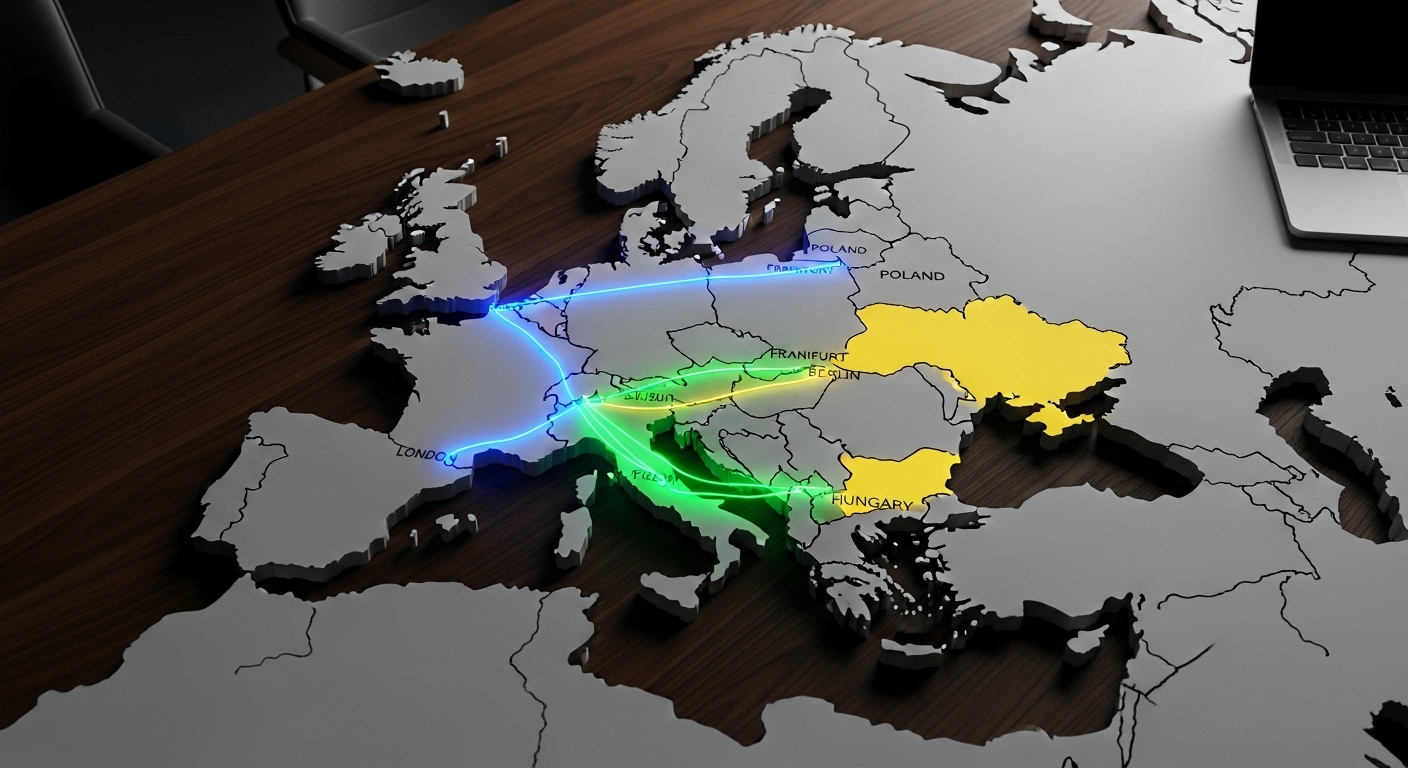Viewing Europe’s business landscape as a mere collection of standalone cities is a relic of the past. Today, the continent operates as a deeply integrated economic network, a complex web of specialized hubs linked by powerful conduits of capital, talent, and data. In the wake of Brexit and fueled by relentless digitalization, the map of European commerce is being redrawn not around individual pins, but along dynamic, high-value corridors. These are Europe’s new economic arteries—the physical high-speed rail lines, the digital data highways, and the intellectual talent pipelines that define modern competitive advantage. Understanding this interconnected system is no longer just an academic exercise; it is the cornerstone of effective corporate strategy. This analysis moves beyond simple rankings to map these critical corridors, from the rebalanced financial axis to the burgeoning tech frontier, providing a strategic blueprint for businesses aiming to position themselves at the very heart of Europe’s economic bloodstream.
The Franco-Germanic Financial Axis: Rebalancing Europe’s Core
The traditional center of European finance has historically been dominated by the City of London. While it remains a global powerhouse, the post-Brexit reality has catalyzed a strategic rebalancing, strengthening the financial artery connecting London to Paris and Frankfurt. This isn’t a replacement but a redistribution of financial gravity, creating a more polycentric core. Paris’s La Défense has successfully attracted banking operations, particularly in trading, leveraging its existing institutional strength and proactive government support. Simultaneously, Frankfurt’s Bankenviertel, home to the European Central Bank, has solidified its role as the EU’s regulatory and banking heartland. The artery connecting these hubs is both physical and digital. Physically, high-speed rail networks like the Eurostar and the Deutsche Bahn’s ICE link these cities in hours, facilitating a seamless flow of executive talent. Digitally, the corridor is reinforced by low-latency fiber optic networks essential for high-frequency trading and secure data transmission between the London Stock Exchange, Euronext Paris, and the Deutsche Börse. A 2023 report from the New Financial think tank noted that over 400 financial firms have moved parts of their business from the UK to the EU, with Paris and Frankfurt being primary beneficiaries. This shift underscores the vitality of this corridor, forcing businesses to adopt a multi-hub strategy to access the full spectrum of Europe’s financial services ecosystem.
The Benelux Nexus: Europe’s Hyper-Connected Commercial Crossroads
Positioned strategically between the UK, France, and Germany, the Benelux region—particularly Amsterdam and Luxembourg—functions as a critical nexus within Europe’s economic circulatory system. It’s the point where multiple arteries converge, creating a hub renowned for its connectivity and stability. Amsterdam’s Zuidas district has transformed into a premier European business location, attracting a potent mix of legal, financial, and tech corporations. Its power is amplified by two key assets: the global reach of Schiphol Airport and the digital supremacy of the Amsterdam Internet Exchange (AMS-IX), one of the largest data transport hubs in the world. This makes it an ideal location for European headquarters that require unparalleled logistical and digital access. Luxembourg, while smaller, carves out its essential role as a global leader in investment funds and private banking. Its stable political climate and specialized regulatory framework make it a secure harbor for international capital. Together, Amsterdam and Luxembourg act as more than just destinations; they are strategic interchanges, allowing companies to efficiently manage pan-European operations, tap into diverse talent pools, and navigate the continent’s complex regulatory landscape from a stable and hyper-connected base.
The Innovation Corridor: Connecting Dublin, Berlin, and the Nordic Tech Hubs
Stretching from the Atlantic edge to the Baltic Sea is a vibrant artery of innovation, less defined by railways and more by the flow of venture capital, data, and human ingenuity. This tech corridor connects Dublin’s ‘Silicon Docks’ with Berlin’s ‘Silicon Allee’ and extends to the dynamic ecosystems of the Nordics. Dublin rose to prominence as the European headquarters for many U.S. tech giants, leveraging a skilled, English-speaking workforce and a favorable corporate environment. It remains a crucial gateway for North American companies entering the European market. Further east, Berlin offers a different flavor of innovation. It’s a magnet for startups and creative technologists, celebrated for its collaborative spirit, vibrant culture, and relatively lower operational costs. The corridor’s strength is its diversity. It’s not a monolith; it includes specialized clusters like Stockholm’s fintech and gaming scene and Helsinki’s deep-tech and mobile technology heritage.
As stated by a CBRE report on European tech, ‘The flow of venture capital across European borders has created a decentralized, yet interconnected, tech network where collaboration between cities like Dublin, Berlin, and Stockholm is fostering a new generation of global companies.’
This artery is built on shared digital infrastructure, a highly mobile tech workforce, and a common ambition to challenge Silicon Valley’s dominance.
The CEE Logistics Backbone: Powering Europe’s Supply Chain from Poland to Hungary
While finance and tech often capture the headlines, the true engine room of the European single market is its logistics and manufacturing backbone, an artery running through Central and Eastern Europe (CEE). Cities like Warsaw, Prague, and Budapest have evolved from low-cost outsourcing centers to sophisticated business service and logistics hubs. This corridor’s strategic importance lies in its geography, acting as the primary conduit between Western Europe’s industrial powerhouses, like Germany, and the continent’s eastern frontiers. Massive investment in infrastructure, funded by both national governments and the EU, has transformed the region. Modern motorways and upgraded rail freight lines now facilitate the efficient movement of goods, making CEE essential for any company involved in manufacturing, e-commerce, or pan-European distribution. Major logistics players and automotive manufacturers have established significant operations here, drawn by a skilled industrial workforce and proximity to key suppliers and consumer markets. For example, Poland has become a European leader in warehouse development and e-commerce fulfillment centers. This CEE artery is the unsung hero of the European economy, ensuring the continental supply chain remains resilient, efficient, and integrated.
The Green Axis: Driving Sustainability from Scandinavia to Germany
A new and increasingly influential corridor is emerging, driven by one of the most powerful forces in modern business: sustainability. The ‘Green Axis’ connects the environmentally conscious economies of Scandinavia with the industrial and technological might of Germany, creating a world-leading hub for green innovation. This corridor is defined not by speed but by shared values and policy, underpinned by the ambitious EU Green Deal. Cities like Copenhagen, Stockholm, and Hamburg are pioneering sustainable urban development, renewable energy solutions, and circular economy models. Business districts within this axis are often distinguished by their high concentration of LEED and BREEAM-certified buildings, reflecting a deep commitment to environmental, social, and governance (ESG) principles. This is more than just a matter of compliance; it’s a powerful magnet for talent and capital. Top professionals are increasingly drawn to companies and cities that align with their values, while investors are channeling funds into businesses that demonstrate strong ESG performance. This axis is where Europe’s future is being built—a future powered by green hydrogen, intelligent energy grids, and sustainable infrastructure, creating a powerful competitive advantage for businesses located within it.
Strategic Cartography: Positioning Your Business on Europe’s Economic Grid
Understanding these economic arteries is the first step; the second is strategically positioning your business within this network. The optimal approach is rarely to place all resources in a single city. Instead, modern strategy often involves a ‘hub-and-spoke’ model that leverages the unique strengths of different corridors. A company might establish its primary commercial headquarters in a hyper-connected nexus like Amsterdam to manage pan-European operations. Meanwhile, it could place its R&D and tech development teams within the Dublin-Berlin innovation corridor to tap into specialized talent pools. For manufacturing and distribution, a presence along the CEE logistics backbone is non-negotiable. The key is to look beyond the city name and analyze the underlying connectivity. Evaluate digital infrastructure for data-intensive operations, map talent pipelines for key skills, and analyze logistical networks for supply chain efficiency. A strategic advisor on global expansion recently commented, ‘Companies that thrive in Europe are those that see it not as a map of countries, but as a grid of capabilities. Your location strategy should be about plugging into the right flows of talent, capital, and information.’ By overlaying your business needs onto this map of economic arteries, you can design a corporate footprint that is resilient, efficient, and perfectly positioned for growth in a complex, interconnected market.
In conclusion, the most insightful view of Europe’s business landscape is not static but dynamic, focusing on the powerful currents that flow between its premier hubs. We’ve traced the continent’s critical economic arteries: the rebalanced London-Paris-Frankfurt financial axis, the hyper-connected Benelux nexus, the vibrant tech corridor from Dublin to the Nordics, the essential CEE logistics backbone, and the forward-thinking green innovation axis. Each corridor offers a distinct set of advantages, and recognizing their interplay is crucial for any organization with European ambitions. The era of choosing a single ‘best’ city is over. Success now lies in strategic distribution, in building a presence that intelligently taps into multiple specialized flows. By viewing Europe as an interconnected network, business leaders can move beyond traditional site selection and architect a corporate presence that is not only located in Europe but is woven into its very economic fabric. The most agile and resilient companies of the next decade will be those who master this new strategic cartography, navigating Europe’s arteries to the heart of opportunity.





